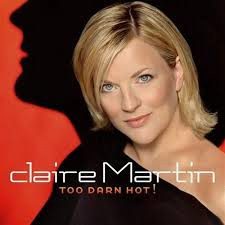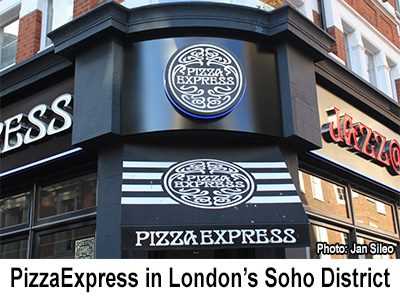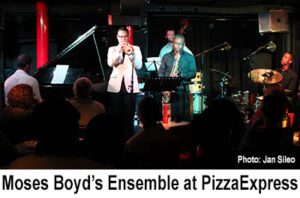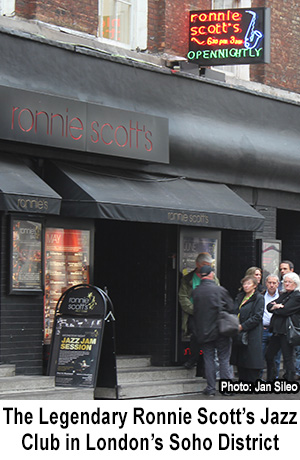On a Tuesday night in May 2013 we soaked up the rustic atmosphere of the 606 Club in London’s Chelsea district and the virtuosic sounds of the Adam Glasser Quintet and the Derek Nash Quartet. The next night we found ourselves in the poshest (and recently renovated) Ronnie Scott’s jazz club in London’s Soho district.
Plush does not even begin to describe the place. Expensive does. While 606 had a reasonable cover and an affordable menu, Ronnie Scott’s has probably the highest cover charge of jazz clubs in all of London: ₤25-₤40 (that’s $40-$65) depending on where you stand (yes, stand) or sit. They charge you for the cloakroom per item, and, according to various web site reviews, the service is not so great. We had the same experience. Ronnie Scott’s—at least from the evening we attended—is the Blue Note of London: the musicians are name acts, but you are also crammed in with not much room to either stretch your legs or your arms, unless it is to reach for your wallet to pay the bill.
This particular evening the featured act was vocalist Claire Martin. She was preceded by a trio led by Ronnie Scott’s artistic director and leader of Ronnie Scott’s Allstars pianist James Pearson. Clearly, Pearson is a pianist with chops, but like the story of virtuoso jazz pianist Art Tatum upon listening to a younger tiger jazz pianist who remarked at the conclusion of the latter’s performance: “Well, he knows what to play, but not why,” Pearson gave the impression in a similar vein. At one point in his set he performed a jazz version of the Rodgers and Hammerstein standard “Surrey with the Fringe on Top” from the 1943 Broadway show “Oklahoma.” He gave credit to the originators of the piece, but forgot to mention that another jazz pianist virtuoso, Canadian-born Oscar Peterson, had already recorded the piece. Pearson performed the piece a la Peterson’s arrangement at breakneck speed, and it was technically impressive, but it lacked the wit that usually emanated from Peterson’s hands. Pearson could have at least given credit where credit was due.
Then came the award-winning British singer Ms. Martin. As a young person Martin claims to have learned all of Judy Garland’s songs. She also gives homage to Ella Fitzgerald as her major influence. At the age of 21, Martin formed her own jazz quartet. In 1991, she was signed by the Scottish jazz label Linn Records. Her debut album, “The Waiting Game,” was released in 1992. The album was selected by The [London] Times as one of their “Albums of the Year.” Later that year, she opened for Tony Bennett at the Glasgow International Jazz Festival. She has released a total of thirteen albums, all on the Linn label. In addition to her singing career, she is also a co-presenter for “Jazz Line Up” on BBC Radio 3. In June 2011,  Martin was appointed Officer of the Order of the British Empire (OBE) in the 2011 Birthday Honours for services to music. Clearly, Ms. Martin is a singer of note, in England at least (http://www.clairemartinjazz.co.uk/).
Martin was appointed Officer of the Order of the British Empire (OBE) in the 2011 Birthday Honours for services to music. Clearly, Ms. Martin is a singer of note, in England at least (http://www.clairemartinjazz.co.uk/).
Her repertoire that evening was right out of the Great American Songbook. And perhaps because I have spent so many years listening to great female American singers—for example, Ella Fitzgerald, Nina Simone, Carmen McCrea, Diane Reeves, and up and coming younger singers like Rachel Kara Perez, among many others—that I know the difference between a great jazz songstress and a vocalist who is above average but not in the top five percent. Or perhaps that particular evening the chemistry between performer and audience was not happening—the audience response was lukewarm and it was clear Ms. Martin was pushing to connect with the packed house. It just wasn’t happening. Her performance lacked peaks and valleys. Her between songs banter was not entertaining. It was as if she had an expectation of strong response from the audience given the build-up from the club master of ceremonies and it never materialized.
Ronnie Scott’s is probably one of the most famous jazz clubs, not only in Britain, but also globally. It is usually a must on anyone’s list of places to visit in London. The roster of performers scheduled to appear there in May-June 2013 was a veritable who’s who in jazz: Madeleine Peyroux, Dave Weckl and Tom Kennedy, Michel Camilo Trio, the Gary Burton New Quartet, Roy Haynes: Fountain of Youth Band, the Tom Harrell Quintet, Monty Alexander, the Kyle Eastwood Band, Eddie Palmieri & the Afro-Caribbean Allstars, and Brubeck Play Brubeck.
We left, or more accurately, we retreated after Ms. Martin’s first set. Even though club management extended a comp to me (arranged in advance primarily due to jazz journalist’s Sabastian Scotney’s good offices), for which I am grateful, I still had to cough up the cover charge for my wife and cousin who accompanied me that evening. From the great high of the night before at 606, the visit to Ronnie Scott’s was a disappointingly expensive evening.
 Our last stop a few days later was the PizzaExpress Jazz Club, also in London’s Soho district on Dean Street. To give this jazz venue some explanatory context, PizzaExpress is a restaurant group with over 400 restaurants across the United Kingdom and 40 overseas in Europe, Hong Kong, India and the Middle East founded in 1965 by Peter Boizot. PizzaExpress’ first restaurant opened its doors in London’s Wardour Street. Inspired by a trip to Italy, Mr. Boizot brought back to London a pizza oven from Naples and a chef from Sicily. PizzaExpress was the first to bring pizza to the UK high street in 1965 and was the first to sell Peroni beer in the UK. In 1969 jazz performances began at its Dean Street restaurant, London, in a well-appointed downstairs space.
Our last stop a few days later was the PizzaExpress Jazz Club, also in London’s Soho district on Dean Street. To give this jazz venue some explanatory context, PizzaExpress is a restaurant group with over 400 restaurants across the United Kingdom and 40 overseas in Europe, Hong Kong, India and the Middle East founded in 1965 by Peter Boizot. PizzaExpress’ first restaurant opened its doors in London’s Wardour Street. Inspired by a trip to Italy, Mr. Boizot brought back to London a pizza oven from Naples and a chef from Sicily. PizzaExpress was the first to bring pizza to the UK high street in 1965 and was the first to sell Peroni beer in the UK. In 1969 jazz performances began at its Dean Street restaurant, London, in a well-appointed downstairs space.
From the low of Ronnie Scott’s, the evening at PizzaExpress Jazz Club was a very welcome uplift. This particular evening there were two ensembles: the Moses Boyd Ensemble and the Hungarian drummer Tamas Berdisz and his combo.
In strong contrast to the very straightforward Great American Songbook sounds heard a few days prior at Ronnie Scott’s, the sounds  of drummer Moses Boyd’s ensemble was heavily gospel and Afro-Caribbean in texture, rhythm, and improvisation. The PizzaExpress Jazz Club described Boyd as follows: “Drummer and band leader Moses Boyd is at the vanguard of the New Wave of British jazz. He is one of the most astounding young artists to have emerged over recent years.” This particular evening Boyd was joined by British alto saxophonist and rapper Soweto Kinch, trumpeter Jay Phelps, bassist Nick Jurd, and Peter Edwards on the piano. The playing was hot and engaging. Mr. Boyd’s drum solos were tasty and witty.
of drummer Moses Boyd’s ensemble was heavily gospel and Afro-Caribbean in texture, rhythm, and improvisation. The PizzaExpress Jazz Club described Boyd as follows: “Drummer and band leader Moses Boyd is at the vanguard of the New Wave of British jazz. He is one of the most astounding young artists to have emerged over recent years.” This particular evening Boyd was joined by British alto saxophonist and rapper Soweto Kinch, trumpeter Jay Phelps, bassist Nick Jurd, and Peter Edwards on the piano. The playing was hot and engaging. Mr. Boyd’s drum solos were tasty and witty.
Biographical material on drummer Tamas Berdisz is sparse, but this is known: After finishing the Musical Technical School in Pécs (Hungary), he graduated in jazz studies from the Liszt Ferenc University of Music in Budapest. He learned to play not only the drums, but also the piano. Latin style music has made the strongest impression on him. From 1995-96 he was a member of the Cotton Club Singers, a Hungarian vocal group founded in Budapest in 1994. In 1996-97 he played in Péter Gerendás’ band, the Hungarian guitarist, composer, and lyricist. From 1997-98 Berdisz worked with Aladár Pege, a Hungarian bassist known as the “Paganini of the double bass.” Since 1998, he has been playing with the Cotton Club Singers and in the “Esti Showder” TV-show as a drummer. He also performs with the Budapest Jazz  Orchestra.
Orchestra.
His set with a supporting trio was merely an opportunity for Berdisz to improvise. And his improvising was full of an exploration of Latin-jazz rhythms. In a way, his supporting trio could well have laid out—the set was really Berdisz’s opportunity to display his rhythmic repertoire. His performance was well received.
Just like 606 Club and Ronnie Scott’s, the PizzaExpress Jazz Club presents performances seven days a week. The menu consists of varied fare, including a cornucopia of drinks from its very well stocked bar, and, of course, a plethora of choices when it comes to pizza!
Of greater import this year was the inauguration of the First Annual London Latin Jazz Festival, curated by pianist Alex Wilson and held at the PizzaExpress Dean Street venue over a period of four nights in September. Alex Wilson is a noted British Latin jazz pianist, arranger and composer. He performed at each of the four concerts.
The schedule included Wilson opening every night with a short solo piano set before the main acts, including:.
– Columbian-born Roberto Pla’s 10 Piece Latin Ensemble (19th Sept) – mambo jazz in the exuberant spirit of Tito Puente.
– Venezuelan percussionist Edwin Sanz, Shanti Paul Jayasinha, Davide Mantovani, and Cuban vocalist René Alvarez (20th Sept).
– On Saturday night (21st Sept) a second Steinway grand piano was forklifted into the club and pianist Jason Rebello and Alex Wilson sat down to explore a musical meeting, accompanied by percussionist Edwin Sanz and Italian groove-meister Davide Mantovani on bass.
– Snowboy and the Latin Section (22nd Sept) – the UK’s very own English Latin conga king.
In a very meaningful way, the PizzaExpress London Latin Jazz Festival was a testament to the most compelling sounds and rhythms heard across the board at the three clubs visited during the summer 2013 sojourn in London. With the exception of Ronnie Scott’s, where the rhythm was strictly swing and the melodies were in the vast majority from the Great American Songbook, the balance of the listening experience was drawn from the Afro-Caribbean, i.e., Latin-jazz musical cauldron. The latter sounded fresh and compelling. The Ronnie Scott’s experience felt dated and flat.
Perhaps it’s all about demographics. Given Ronnie Scott’s high price tag that only the well-to-do and so-called cotton tops can afford, the jazz sounds of yesteryear are probably what the audience wants to hear—it is familiar and familiar draws an audience. But if this same demographic, plus a younger generation wants to experience newer, more worldly music that incorporates sounds and rhythms that go beyond the boundaries of Harlem’s HarlemCotton Club and jazz clubs on New York City’s 52nd Street of yesteryear, then 606 Club and PizzaExpress Jazz Club, and many other venues in London’s jazz scene, are the places to go.
In London, there’s jazz for every taste.
Please write to me at meiienterprises@aol.com if you have any comments on this or any other of my blogs.
Eugene Marlow, Ph.D.
December 23, 2013
© Eugene Marlow 2013


